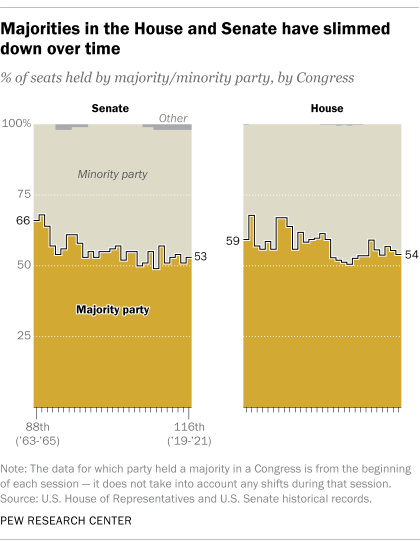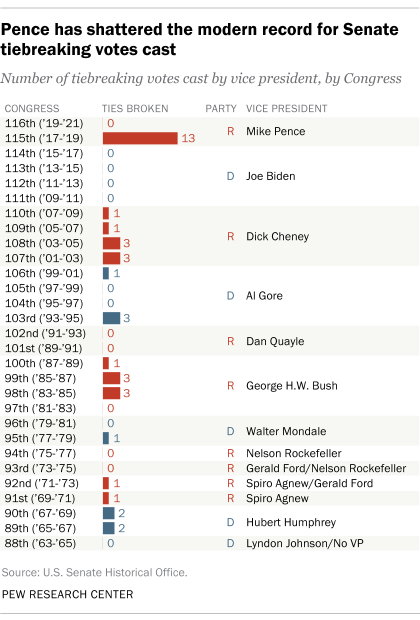
Election Day is in the rearview mirror, but it’s still not clear whether Republicans or Democrats will have the majority in the U.S. Senate next year. That won’t be decided until early January, when voters in Georgia fill two seats in runoff elections. Leading up to the runoffs, Republicans have secured 50 Senate seats and Democrats have 48 (this includes the two independent senators who caucus with the Democrats).
Regardless of how the elections in Georgia turn out, the Senate will be closely divided next year. And that is part of a long-running trend: Narrow partisan divides in the Senate and the House of Representatives have become more common in recent decades, according to a Pew Research Center analysis of historical data going back to the 88th Congress (1963-1965), the first Congress with 100 senators and 435 representatives.
We conducted this analysis to understand whether and how the size of congressional majorities has changed over time.
The analysis uses archival records from the historical offices of the U.S. House of Representatives and U.S. Senate. Information about the upcoming runoff elections in Georgia comes from news reports.
For comparative purposes, we began our analysis in the 88th Congress (1963-1965), the first Congress with 100 senators and 435 representatives. The data for which party held a majority in a Congress is from the beginning of each session – it does not take into account any shifts during that session.
The largest majorities in the Senate and House during this stretch occurred in the 1960s – and both were Democratic majorities. Democrats held 66% of Senate seats in the 88th Congress and nearly seven-in-ten House seats (68%) in the 89th Congress of 1965-1967. Since then, the size of the majorities in both chambers has generally trended downward. By the late 1990s and early 2000s, the partisan split in both chambers hovered around 50-50.
Next year’s 117th Congress has the potential to be one of only two in the last six decades in which Democrats and Republicans have the same number of Senate seats at the beginning of the term. The last time it happened was the 107th Congress (2001-2003), when each party held 50 seats.
In the House, Democrats are expected to have a slim majority next year. The narrowest House majorities in the six decades we examined occurred in the 106th and 107th Congresses, when Republicans made up just over half (51%) of the chamber, holding 223 and 220 seats, respectively. (A party usually needs at least 218 seats for a majority in the House, but, due to vacancies, the number can be lower.)
Breaking Senate ties
If Democrats win both runoff elections in Georgia in January, they would gain control of the Senate due to the potentially tiebreaking vote of Democratic Vice President-elect Kamala Harris.
Harris would follow a vice president who made record use of his ability to break ties in the Senate: Current Vice President Mike Pence has cast 13 tiebreaking votes, more than any vice president in the modern era of the chamber.
Pence cast all 13 of his tiebreaking votes during the 115th Congress (2017-2019), blowing past the previous high for ties broken in a single congressional session: three, by former vice presidents Dick Cheney (107th Congress in 2001-2003, 108th Congress in 2003-2005), Al Gore (103rd Congress in 1993-1995) and George H.W. Bush (98th Congress in 1983-1985, 99th Congress in 1985-1987).
Cheney previously held the modern record for total ties broken during a vice presidency. All told, Cheney cast eight tiebreaking votes during the eight years of the George W. Bush administration.
Cheney and Pence served as vice president during periods with razor-thin Senate majorities. During three of the four Senate sessions Cheney presided over, the majority party held 51% of seats or fewer. And when Pence cast his record-breaking number of tiebreaking votes, the majority party (Republicans) also held 51 Senate seats.
President-elect Joe Biden, who served for eight years as Barack Obama’s deputy, did not cast any tiebreaking votes when he was vice president.
The long-term narrowing of congressional majorities has come amid growing partisan polarization in the United States. It has also created more opportunities for partisan control to flip. For example, Democrats held the House from the 1960s until 1994, when Republicans secured the majority. In just the last 14 years, by comparison, control of the House has changed hands three times.


